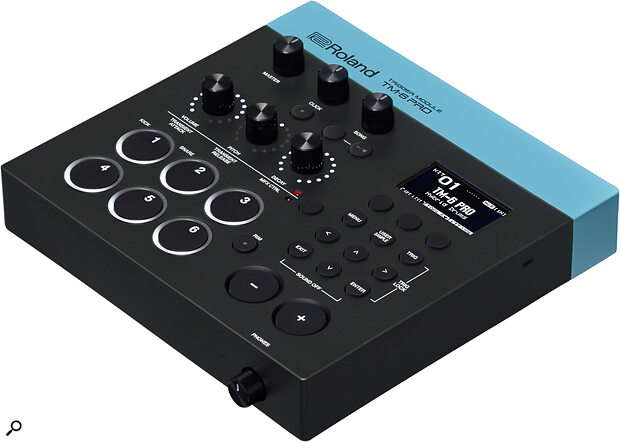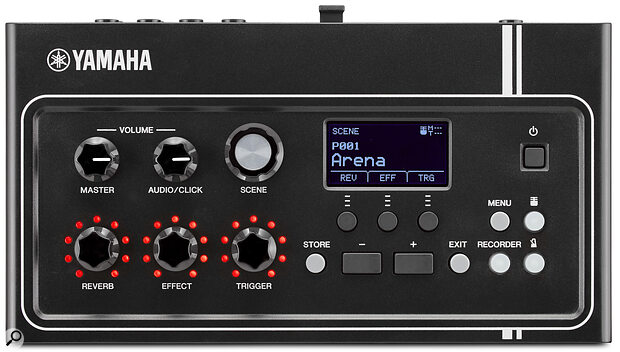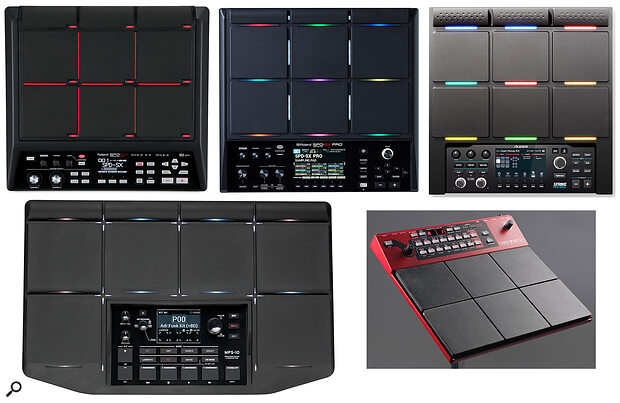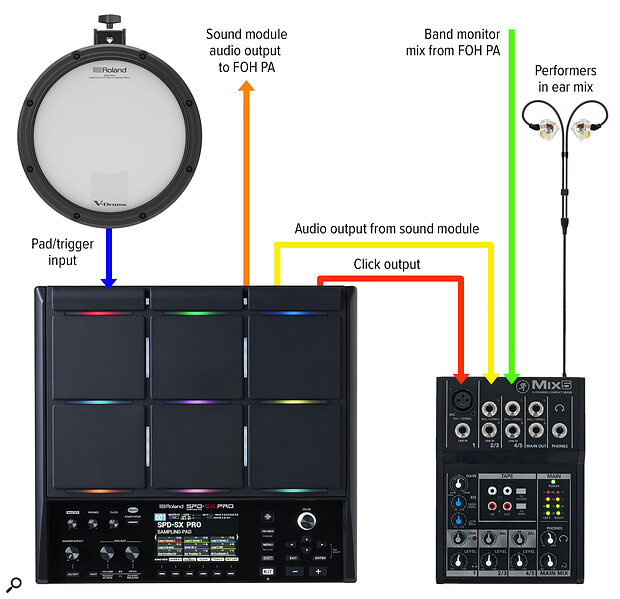 Photo: Sarah Watts Point and Shoot
Photo: Sarah Watts Point and Shoot
What is Hybrid Drumming? And why do you need it?
Hybrid drumming involves the integration of drum pads, triggers and other electronic components into a traditional drum kit setup, enabling you to blend the sounds of acoustic drums with a wide range of electronic sounds and effects. Incorporating electronics into your acoustic kit not only allows the production values of today’s modern music to be reproduced live, it can also introduce a unique level of creativity into your playing that can’t be achieved with acoustic drums alone.
While rock drummers like King Crimson’s Bill Bruford and Rush’s Neil Peart were among the earliest hybrid drumming innovators, the trend exploded in the late ’80s with the New Romantic bands like Duran Duran, and occasionally more edgy acts like New Order, adding electronic components to their percussive arsenals. But things have moved on a long way since adding a couple of Simmons pads was considered cutting edge, and the technology has become more advanced, more affordable and — equally important — more reliable. Modern music demands a wider palette of sounds than ever before, and hybrid drumming is fast becoming something that many drummers are exploring.
Triggering Your Acoustic Kit
 The Roland RT‑MicS is a trigger with built‑in sounds that clips to a drum hoop.
The Roland RT‑MicS is a trigger with built‑in sounds that clips to a drum hoop.
Augmenting an acoustic kit with triggered sounds is a great way to beef up your drum sounds or add additional elements, such as a tambourine or clap, to a snare.
Triggers themselves come in two formats: single and dual. They attach directly to your acoustic drum shells, typically mounting to the top hoop of each drum. Once a trigger is tightly secured to the drum, a small piezoelectric sensor rests on the drum head, detecting the vibrations generated when your drum stick strikes it, and sends that data to a drum module (your source of sounds) via a jack or XLR cable. The single‑trigger option only sends a signal when the batter head is struck, but a dual trigger, as its name suggests, includes two transducers that take signals independently from the head and rim of the drum, allowing two different sounds to be played.
Roland, Yamaha, 2Box, Ddrum and many other manufacturers all produce triggers spanning a wide range of prices, build quality and style. They all work in pretty much the same way, so my advice for anyone looking to buy would be to choose what suits your budget and the physical requirements of your drums — not every trigger will fit perfectly on every drum hoop. You can buy very simple piezo pickups that stick to the drum head and have a trailing jack socket attached but, in my experience, these are impractical and don’t give great results. I’d avoid those and go for something more substantial.
The Simple Options
Keeping it simple, something like the Roland RT‑MicS is a great way to start. This self‑contained unit clips onto your snare drum (or any other drum in your kit) and has eight built‑in sounds that are triggered as you hit the drum, so no external sound module or cabling is required. In addition to the snares, claps and percussion sounds the unit ships with, you can also add two of your own sampled sounds, to customise your sound palette somewhat. Roland also produce a two‑channel version (the TM‑2), should you want to add a kick and snare trigger, or you could go for the six‑input TM‑6 Pro, which (as its name suggests) offers six trigger inputs. I reviewed the latter device for Sound On Sound in the December 2018 issue. With a fully featured unit like the TM‑6 Pro, you can add triggers to your kick, snare and toms or incorporate external pads into your setup. We’ll come on to that last bit later.
 Designed for hybrid drumming: the Roland TM‑6 gives you six trigger inputs and a huge range of sounds to play with.
Designed for hybrid drumming: the Roland TM‑6 gives you six trigger inputs and a huge range of sounds to play with.
Also worthy of a mention at this point is the Yamaha EAD10, whose initials stand for Electronic Acoustic Drums. This is a slightly different proposition but, having also reviewed it for SOS, I know it would fit very nicely into a hybrid drum setup. In addition to the kick and snare triggers, the EAD10 features a stereo microphone that captures the rest of the kit and allows you to process it through a range of effects. Its compact and uncluttered format means you won’t have to spend time setting up multiple triggers and mics or dealing with cables trailing all over your kit, but be aware that the microphones will potentially pick up other sounds on stage.
 Yamaha’s EAD10 drum module has kick and snare triggers, and a stereo microphone that allows you to process the rest of the kit.
Yamaha’s EAD10 drum module has kick and snare triggers, and a stereo microphone that allows you to process the rest of the kit.
Triggers Or Pads?
Using triggers attached to acoustic drums, on the one hand, and adding pads to a kit, on the other, are both methods that have their place, and each works better for different things. Obviously, with a trigger attached you’re still going to hear the drum alongside the triggered sample, so this is ideal for augmenting acoustic sounds. Drum pads, however, make no sound (certainly in a live scenario) and are ideally suited to triggering samples for which you don’t want an acoustic element. Adding a subtle 808 snare or conga, for example, would be better accomplished via a discrete drum pad than via a trigger attached to a drum.
 The Roland BT‑1 is a trigger pad that can attach to your drum head or be mounted on its own stand.Pads work in exactly the same way as a trigger: a rubber or mesh pad connects to your drum module. If adding one or more drum pads to your acoustic kit is either physically or aesthetically challenging, the Roland BT‑1 bar trigger is a great option to consider, as it takes up far less space than a typical drum pad.
The Roland BT‑1 is a trigger pad that can attach to your drum head or be mounted on its own stand.Pads work in exactly the same way as a trigger: a rubber or mesh pad connects to your drum module. If adding one or more drum pads to your acoustic kit is either physically or aesthetically challenging, the Roland BT‑1 bar trigger is a great option to consider, as it takes up far less space than a typical drum pad.
Other great options for the hybrid drummer are sample pads such as the Roland SPD range, the Alesis Strike MultiPad, the Yamaha DTX‑Multi 12 and the brand‑new Korg MPS‑10, all of which have been reviewed in SOS.
These units all provide a compact solution combining pads, trigger inputs and built‑in sounds, along with sampling capabilities, allowing your own unique sounds to be incorporated. The SPD, in its various guises, from the original SPD‑S to the SPD‑SX and new SPD‑SX Pro, has been my weapon of choice in my own hybrid drumming setup for many years. It has an incredible set of functions and features that let me bring a high level of creativity to my acoustic drum performances.
More Than Percussion
How about adding more musical elements to your electronic arsenal, such as keyboard sounds and effects? Of course, anything tempo related will need to be played ‘in time’, which opens the tricky subject of playing to a click, but there are many ways you can enhance a performance without needing a cowbell banging in your ear at 150dB.
Playing back keyboard pads and ambient soundscapes is a great way to augment songs if you don’t have a keyboard player and want to add something extra. By sampling chords into your drum module and assigning them to individual pads, you can trigger them as required by hitting the appropriate pad. The majority of sample pads allow you to create mute groups, which automatically silence one pad when another is struck. This means you can make your samples extra long (memory permitting) and they will simply end when you play the next pad.
You could also assign individual notes to pads and, with some level of dexterity, play melodies and phrases. If you’re looking for something very much on the creative side, rather than simply triggering samples, the Nord Drum 3P is a really interesting option, a little bit like a synth for drummers!
 Drum pads like the Roland SPD range, Alesis Strike MultiPad, Korg MPS-10 or Nord Drum 3P can make a great all-in-one pads+sounds combination.
Drum pads like the Roland SPD range, Alesis Strike MultiPad, Korg MPS-10 or Nord Drum 3P can make a great all-in-one pads+sounds combination.
If you’re comfortable playing to a click (or have an alarmingly good sense of tempo), you can start to expand into triggering tempo‑based elements, which can include keyboard parts, percussion loops and even vocal phrases.
In my experience, it’s a good idea to keep phrases as short as possible and retrigger them often, rather than hitting a pad and hoping a 30‑ or 40‑second loop will remain in time. For example, if you want to add a percussion part to a chorus, make the loop a bar long and retrigger it every bar rather than using an eight‑ or 16‑bar phrase. If you trigger the loop a fraction early or late, it will be horribly out of time after 16 bars has run its course.
I’ve added backing vocals and drum loops live using the SPD‑SX. With the benefit of the many clever playback options these units offer, such as mute groups and pad linking (see the reviews for more details), it can be a lot simpler than you might expect to create and control quite complex backing.
Electronics can add an exciting and creative dimension to your playing that has almost endless possibilities.
Expanding Horizons
Hybrid drumming has become a ‘must have’ in a lot of modern professional drumming setups. You only have to watch a few ‘rig rundowns’ on YouTube to see how many sample pads, drum modules and triggers are being used. But with the technology available from manufacturers such as Roland, Yamaha, Alesis and others, it is not difficult to incorporate electronics into any acoustic setup, however modest. Electronics can add an exciting and creative dimension to your playing that has almost endless possibilities.
At The Mercy Of Monitoring
As drummers, we’ve been in the enviable position of never having to worry where the power sockets are at a gig. The room itself has always had the most impact on the sound of an acoustic kit, but as a hybrid drummer a few new and important considerations become part of our remit. Previously, the PA was something to enhance the already relatively loud acoustic drums, but now it’s the only way any electronic sounds can be heard. There are two elements to consider here: the front‑of‑house sound (what the audience hears); and monitoring (what you hear). I won’t delve into the front‑of‑house side of things too deeply, as that would be very much an article in itself, but be aware that the PA will dictate how the electronic elements of your kit sound to your audience. If you’re hybrid drumming in a small band gigging in pubs and clubs, the PA will now be required for more than simply the vocals, so you may need to upgrade or add to your existing system.
Monitoring also becomes very important — it’s the only way YOU can hear the non‑acoustic elements of the kit. If you are using tempo‑based loops and sounds you will also need to be able to hear the click clearly.
There are a number of ways of creating a good monitor setup for a hybrid drum kit, but a compact mixer is one of the easiest and most robust. The majority of drum modules will allow the click output to be routed independently, so you can bring this into a channel of your mixer alongside the other sources you need to hear. If you have multiple outputs on your drum module, you can send one feed into your mixer and another to the front of house. Finally, you can bring a monitor mix of the rest of the band into the mixer, giving you the ability to balance the band, your electronics and (if you are using one) the click. It’s possible to work with a regular monitor wedge, but a good pair of IEMs (in‑ear monitors) is a far better solution, and really the only option if you’re using a click and don’t want the audience to hear it. Not only will you get a great mix of the band and your electronics, you’ll also be protecting your ears!
Read More About It!
Many of the products covered here have been reviewed in depth in SOS. Here are some handy links...
- Roland TM‑6 Pro: www.soundonsound.com/reviews/roland-tm-6-pro
- Yamaha EAD10: www.soundonsound.com/reviews/yamaha-ead10
- Clavia Nord Drum 3P: www.soundonsound.com/reviews/clavia-nord-drum-3p
- Roland SPD‑SX: www.soundonsound.com/reviews/roland-spdsx
- Roland SPD‑SX Pro: www.soundonsound.com/reviews/roland-spd-sx-pro
- Alesis Strike MultiPad: www.soundonsound.com/reviews/alesis-strike-multipad
- Yamaha DTX‑Multi 12: www.soundonsound.com/reviews/yamaha-dtx-multi-12
- Korg MPS‑10: www.soundonsound.com/reviews/korg-mps-10

